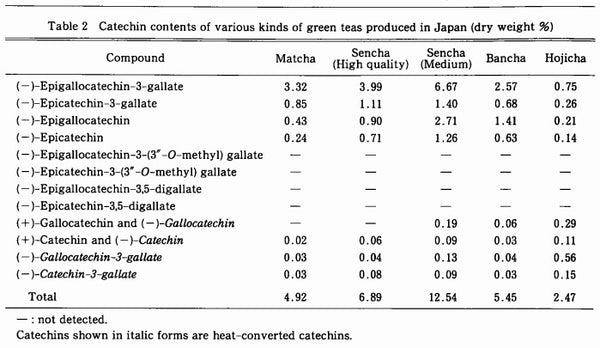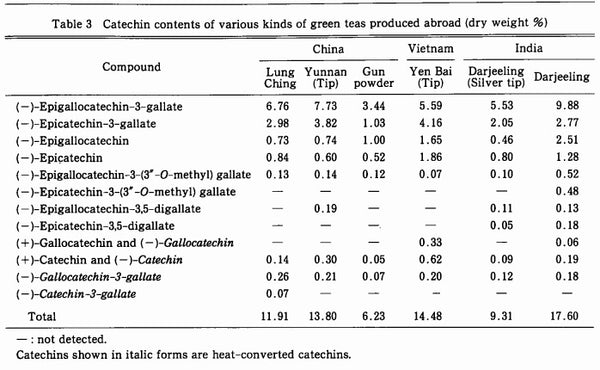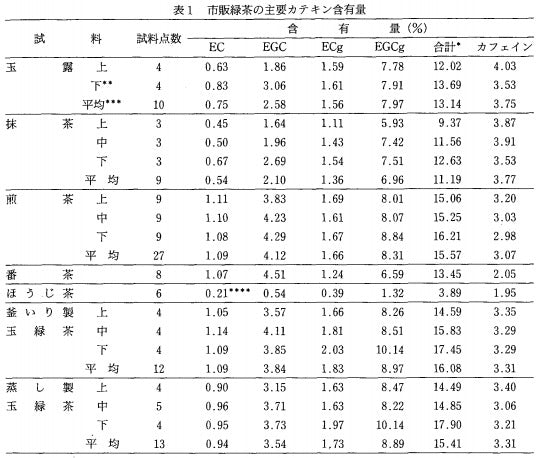Matchan myytti
Monet yritykset lainaavat väärin tietyn tutkimuksen, jossa tutkitaan EGCG:n (erityinen katekiinityyppi, joka on itsessään eräänlainen antioksidantti) tasoja. Nämä yritykset sanovat, että matchassa on 137 kertaa enemmän antioksidantteja kuin vihreässä teessä.
Green Tea Guiden ja Matcha Mind Tean blogiviestit osoittivat erityisesti, mistä tämä luku oli peräisin, Coloradon yliopistossa tehdyssä tutkimuksessa.
Tuo tutkimus , kuten monet muutkin, on tutkittava tarkemmin (ja tietysti luettava, jos mahdollista). Mutta jopa katsomalla abstraktia (alla) voit nähdä, kuinka markkinoijat ovat ottaneet luvun "137" irti kontekstista (kohokohdat ovat minun):
Vihreän teen katekiinien tiedetään olevan monia hyödyllisiä terveydellisiä ominaisuuksia. Viime aikoina on ehdotettu, että matchalla on suurempia mahdollisia terveyshyötyjä kuin muilla vihreällä teellä. Matcha on erityinen jauhettu vihreä tee, jota käytetään japanilaisessa teeseremoniassa. Ei ole kuitenkaan tehty tutkimuksia matchasta saatavan katekiinin saannin määrittämiseksi tavalliseen vihreään teehen verrattuna. Olemme kehittäneet nopean menetelmän viiden katekiinin ja kofeiinin analysoimiseksi matchassa käyttämällä misellielektrokineettistä kromatografiaa. Tulokset esitetään matchan vesi- ja metanoliuutteilla verrattuna suositun vihreän teen vesiuuttoon. Vertailulla mg katekiinia/g kuivaa lehtiä tulokset osoittavat, että matchan juomisesta saatavan epigallokatekiinigallaatin (EGCG) pitoisuus on 137 kertaa suurempi kuin China Green Tips -vihreän teen EGCG:n määrä ja vähintään kolme kertaa suurempi kuin suurin kirjallisuusarvo muille vihreille teelle .
China Green Tips on tietysti erityinen Starbucksin teetuote , ei vihreä tee yleensä. Sekä Green Tea Guide että Matcha Mind Tea huomauttavat, että 137x keskimääräistä vihreää teetä korkeampi taso olisi vaarallista .
Entä jauhettu vihreä tee?
Japanissa yleistä niille, jotka haluavat lisätä katekiinin saantiaan ravinnosta vihreän teen avulla, juovat jauhettua vihreää teetä . Itse asiassa keskimäärin lähes kaikissa vihreässä teessä (paahdettu hojicha on poikkeus) on enemmän katekiinia kuin matcha, jos sitä kulutetaan jauheena.
Analyysi tutkimuksesta " Katekiinien HPLC-analyysi erityyppisissä Japanissa ja ulkomailla tuotetuissa vihreissä teessä " osoittaa katekiinien tasot prosentteina kuivapainosta:


Saijo, Ryoyasu* ja Yoshiyuki Takeda**. " Katekiinien HPLC-analyysi erityyppisissä Japanissa ja ulkomailla tuotetuissa vihreissä teessä ", Nippon Shokuhin Kagaku Kogaku Kaishi Voi. 46, nro 3 . 138-47 (1999).
* Kasvatustieteellinen tiedekunta, Kagawa University, Saiwaicho 1-1, Takamatsu-shi Kagawa 760-8522
** Teenviljelyn laitos (Makurazaki), NIVOT, Beppu 14041, Makurazaki-shi Kagoshima 898-0032
Mielenkiintoista on, että toinen tutkimus, "Yksittäisten teen katekiinien ja kofeiinin sisältö japanilaisessa vihreässä teessä", osoittaa hyvin erilaisia prosenttiosuuksia, vaikka tässä tutkimuksessa tarkastellaan paljon enemmän näytteitä Japanista peräisin olevista vihreästä teestä (yhteensä 85 näytettä eri teetyypeistä). Tässäkin matchassa on kuitenkin vähemmän kuin muissa vihreässä teessä hojichaa lukuun ottamatta.
Ylhäältä alas: Gyokuro korkea laatu, gyokuro huono laatu, gyokuro keskimäärin; Matcha korkea laatu, matcha keskilaatuinen, matcha huono laatu, matcha keskimääräinen; Sencha korkea laatu, sencha keskilaatuinen, sencha heikko laatu, sencha keskimääräinen; bancha, hojicha, pannulla poltettu tamaryokucha korkea, keskitaso, matala, keskimääräinen; höyrytetty tamaryokucha korkea, keskitaso, matala, keskitaso.
Ensimmäinen numerosarake näyttää näytteiden lukumäärän. Toiseksi viimeiseksi luetellaan katekiinien kokonaismäärä, viimeisessä sarakkeessa kofeiini.
Goto, Testuhisa, Hitoshi Nagashima, Yuko Yoshida ja Masaaki Kiso. " Yksittäisten teen katekiinien ja kofeiinin sisältö japanilaisessa vihreässä teessä ", Chagyo Kenkyu Hokoku (Tea Research Journal), Voi. 1996 (1996) nro 83. 21-28.
Testuhisa Goto ja Hitoshi Nagashima ovat National Food Research Institutesta. Yuko Yoshida ja Masaaki Kiso ovat Tokyo Metropolitan Agricultural Experiment -asemalta.
Löytää tasapaino terveyden ja maun välillä
Tärkeintä on muistaa, että katekiini maistuu kitkerältä. Mitä katkerampaa teesi on, sitä suurempi on katekiinin määrä. Jos pidät kiinni teelehdistä, yli 80 C/176 F asteisessa vedessä liotettu tee on katkerampaa kuin sama teelehti tämän tason alapuolella (kokeile tätä varjostetulla gyokurolla tai kabusechalla !). 80 C on kynnys, jossa suurin osa katekiinista uutetaan.
Jauheisessa teessä jotkut teet ovat melko hyviä rajoittamaan katkeruutta huolimatta siitä, että ne kuluttavat koko lehden. Kuten matcha, koska syöt koko lehden, pystyt saamaan suurimman määrän antioksidantteja kehoosi.
Kuvan luotto: kazoka / Shutterstock




6 kommenttia
The methanol extraction of the powder vs the water extraction of the green tea may not be as bad a comparison as you would first think.
The water extraction of the green tea is what the person actually consumes, so it is easy to then prepare this sample for the chromatography and assess what is present.
The matcha powder is fully consumed, so it needs to be understood what is present in the powder. To see what is present, the powder needs to be prepared in such a way that the chromatography method can detect what compounds are present. This usually takes form in a methanol extraction.
The methods and comparison are fine, the only caveat that should be included is that while there may be 137x the compounds present in match vs green tea, there is the very real possibility (and high probability) that the body would not be able to extract that full amount.
Hi Marc, First of all, you do need to be careful about generalizing. Ichibancha or first flush and nibancha or second flush, refers only to the specific flush, and says nothing about cultivation or production. Given the exact same amount of exposure to sunlight and the same tea field, I would say that first flush leaves have more of all components. If you shade the leaves, there will be less exposure to sunlight so more theanine and less catechin. Most farmers allow their second flush to grow longer (resulting in more sunlight exposure) to get a larger crop yield, so the tendency is for more catechin. But I would say the second flush also has less caffeine.
Hi Ian,
Is it accurate that Shincha/Ichibancha sencha has less caffeine, less catechins but higher amino acids (I assume that by higher amino acids, people refer mainly to L-theanine ) than Nibancha harvested sencha ?
My understanding is that catechins are actually produced from L-theanine with the help of direct/full sun exposure. Since Shincha/ichibancha means spring harvest, such leaves have seen little sun exposure, so I’d expect the claim of higher L-theanine and lower amount of catechins to be accurate. However, I’m not so sure about lower amount of caffeine. The reason I say that, is because gyokuro which generally has higher amounts of L-theanine than sencha, also has higher amounts of caffeine than sencha.
As far as I know the effects of green tea relies on the ratio of three main components : theanine, catechins and caffeine.
I’m looking to find the general ratios of the above in both ichibancha and nibancha. Off the top of my head, as far as Nibancha, I’d assume lower amounts of L-theanine, higher amounts of catechins and lower amounts of caffeine.
Am I mistaken ?
Many thanks
Hi Marc, I am not a food scientist, so I am speaking only with knowledge as someone who has read a lot about this in Japanese. “Sencha Nagashima” is almost certainly a product name, not a type of sencha, so I am going assume that the “high fired” term you use is 火入れ in Japanese, hi-ire, what we call “green roasting” here on Yunomi, and a process where you heat sencha in a roaster on low heat for a short time so as not dry it out more without actually roasting it. This has the effect of reducing moisture from unrefined tea leaves (aracha) at 5% to 1-2%, imparting a sweet toastiness without removing too much of the vegetal flavor, and allows for storage of 6-18 months much less decline in quality.
I do know that roasting the leaf to the point of hojicha reduces the amount of caffeine and reduces the catechin in the leaf. How much green roasting reduces this is something I do not know though.You can see the general difference between sencha and hojicha here: https://yunomi.life/blogs/japanese-tea-guide/japanese-tea-nutrition-chart
I’ll take a look to see if any Japanese research has been done on this hi-ire process.
This question is about Japanese sencha :
Mood wise I benefit from most first-flush sencha, but one ; sencha Nagashima which is a high-fired tea. I suspect this lack of effect has to do with it being high-fired. I’ve seen an HPLC analysis of that tea and it’s been found to have a high amount of polyphenols – though this is a bit vague as there are many types of polyphenols present in sencha.
Do you think the high-firing process causes polymerization ? This might explain why it’s been found to have a high amounts of polyphenols and why I don’t get the mood benefit from this one tea.
This question is about Japanese sencha.
I’ve been drinking sencha for 9 years now. I drink sencha for the overall experience and the effect it has on my mood and overall health. Most sencha improve my mood.
One type of sencha however, doesn’t produce that effect – it is high-fired sencha (i.e. Sencha Nagashima). I’m wondering why that is ? I’ve seen an HPLC analysis of that tea and it has a high amount of polyphenols – though, that is somewhat vague, as there are many types of polyphenols in sencha.
I’m pretty sure it has to do with it being high-fired where other sencha teas I drink aren’t.
Could the high-fired process cause polymerization ? That might explain why it has a high amount of polyphenols and why I don’t benefit from that tea.
Thank you